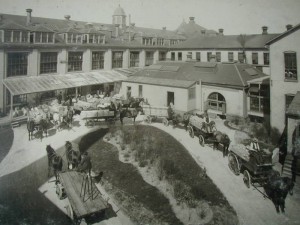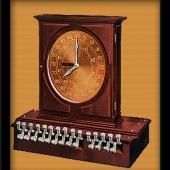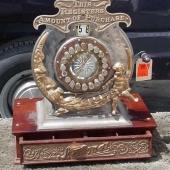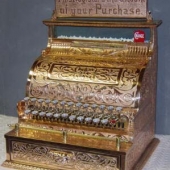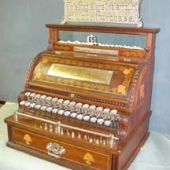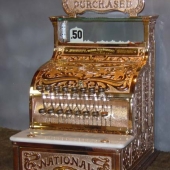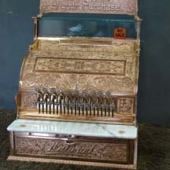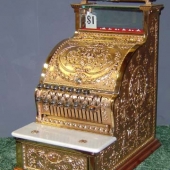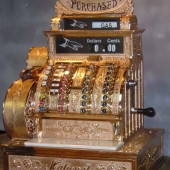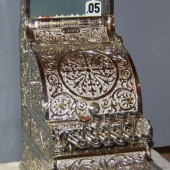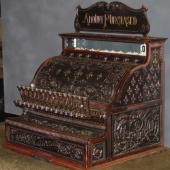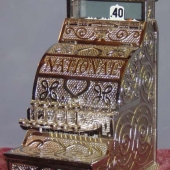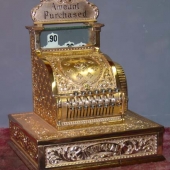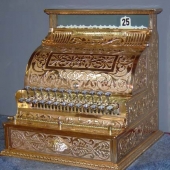A Brief History of NCR
Invented in 1880, Jack Ritty’s Incorruptible Cashier forever changed the way retail establishments would conduct everyday business. The first machines were sold not only for their functional ability, but also on their beauty – a fixture which every store owner would be proud to display in his establishment. The first cash registers were housed in elegant cabinets of polished wood. In 1888 ornate cases of brass and cast iron were produced. These fancy cases on cash registers ceased in 1915 due to demand for brass during World War I. Less expensive sheet metal versions were then produced and the era of the brass cash register ended after only 27 years.
Even though brass cash registers have not been manufactured since 1915, they were refurbished and sold as used registers for the next three decades. In some cases, they can even be found in use today. The quality of the mechanisms in these machines, as well as the timeless beauty of their ornate cases, make it easy to understand why these one-time common business machines have become such a sought-after and coveted antique.
Examples of early registers
Model Number
The model is the key to what your register is. The model number and serial number are usually located on a tag on the front of the machine. Before 1909, registers were either a one- or two-digit model number, for example, model 2, 50, 92. If your register is a push-key register and was made before 1909, the model number is usually located on an oval tag to the right of the register directly under the glass (it may say “size”). If your register has a crank on the right side, the model number is usually located on a badge between the push buttons. After 1909, National switched to a class system, and the model numbers changed. For example, a model 72 changed to a model 442 after 1909.
If your register was made after 1909, it is located on a plate dead center of your register directly under the glass. It should look like this:
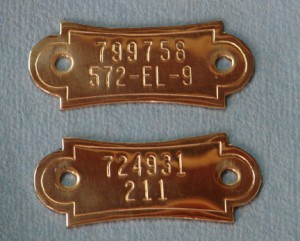 The top number is your serial number. The bottom number is your model number. The top tag represents a model 572 that has an electric motor (EL) and has 9 drawers. So, this tag is for a floor model. The other letters you may find are:
The top number is your serial number. The bottom number is your model number. The top tag represents a model 572 that has an electric motor (EL) and has 9 drawers. So, this tag is for a floor model. The other letters you may find are:
G – which is the kind of autographic printer that is on your register
L – Lights on your register
C – A fairly large register with more than one drawer that sits on a cabinet
F – A floor model register
If this tag is missing, the information might be found on a paper tag on the bottom of the cash drawer. Please refer to our parts section, we do have the capabilities to make tags. The bottom number is the model number. This model number is very important when trying to establish what kind of register you have.
Serial Number
The below table is a guide to tell you what year your National Cash Register was shipped from the factory. Registers were numbered sequentially, and not according to what model they were. The serial number is the above number on the tag on the front of your machine.
|
Year |
Serial Number |
Year |
Serial Number |
| 1889 | 10,000 – 20,000 | 1903 | 310,000 – 370,000 |
| 1890 | 20,000 – 30,000 | 1904 | 370,000 – 430,000 |
| 1891 | 30,000 – 40,000 | 1905 | 430,000 – 490,000 |
| 1892 | 40,000 – 60,000 | 1906 | 490,000 – 550,000 |
| 1893 | 60,000 – 70,000 | 1907 | 550,000 – 610,000 |
| 1894 | 70,000 – 90,000 | 1908 | 610,000 – 690,000 |
| 1895 | 90,000 – 100,000 | 1909 | 690,000 – 800,000 |
| 1896 | 100,000 – 120,000 | 1910 | 800,000 – 940,000 |
| 1897 | 120,000 – 140,000 | 1911 | 940,000 – 1,080,000 |
| 1898 | 140,000 – 160,000 | 1912 | 1,080,000 – 1,220,000 |
| 1899 | 160,000 – 200,000 | 1913 | 1,220,000 – 1,370,000 |
| 1900 | 200,000 – 230,000 | 1914 | 1,370,000 – 1,470,000 |
| 1901 | 230,000 – 270,000 | 1913 | 1,220,000 – 1,370,000 |
| 1902 | 270,000 – 310,000 | 1914 | 1,370,000 – 1,470,000 |
If your register has a serial number that begins with an “S”, this means that at some point your register was sent back to the factory to either be repaired or resold. It may have endcaps that don’t have holes in them to accommodate a top sign. While it is impossible to tell when the register was originally sold from the factory, the S machines were numbered as follows:
| S-1 | January 1880 | S-1000 | April 1893 | |
| S-3000 | September 1894 | S-5000 | August 1896 | |
| S-7000 | February 1898 | S-9000 | April 1899 | |
| S-11000 | February 1900 | S-13000 | October 1900 | |
| S-15000 | July 1901 | S-17000 | February 1902 | |
| S-19000 | September 1902 | S-21000 | May 1903 | |
| S-23000 | November 1903 | S-25000 | April 1904 | |
| S-27000 | July 1904 | S-29000 | January 1905 | |
| S-31000 | July 1905 | S-33000 | December 1905 | |
| S-35000 | March 1906 | S-37000 | June 1906 | |
| S-39000 | October 1906 | S-41000 | December 1906 | |
| S-43000 | March 1907 | S-45000 | May 1907 | |
| S-47000 | July 1907 | S-49000 | September 1907 | |
| S-51000 | October 1907 | S-53000 | December 1907 | |
| S-55000 | February 1908 | S-57000 | May 1908 | |
| S-59000 | August 1908 | S-61000 | October 1908 | |
| S-63000 | January 1909 | S-65000 | March 1909 | |
| S-67000 | May 1909 | S-69000 | September 1909 | |
| S-71000 | December 1909 | S-73000 | May 1910 | |
| S-75000 | November 1910 | S-77000 | June, 1911 | |
| S-79000 | January 1912 | S-81000 | October 1912 | |
| S-83000 | June 1913 | S-85000 | January 1914 | |
| S-87000 | August 1914 | S-89000 | January 1915 | |
| S-91000 | March 1915 |
Case Design
National cash registers were made in red brass, nickel plate, and copper oxidized. If your register looks to be in different colors of brass, this is because at some point somebody has stripped off the old nickel plate. If your register was originally nickel plate, then most likely your drawer front is solid nickel, because this is the piece of the register that was touched most often, and National put solid nickel drawer fronts on the register so the nickel plate wouldn’t wear off. It is highly unlikely that if your register is a nickel plated register, that it will be completely one color under the nickel plate. This is because when National was putting their registers together, when they got a batch from the foundry that was different colors, National nickel plated the register.
